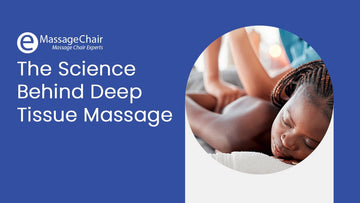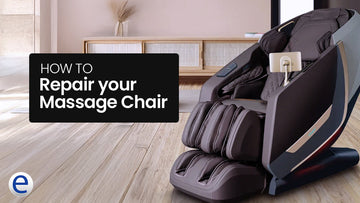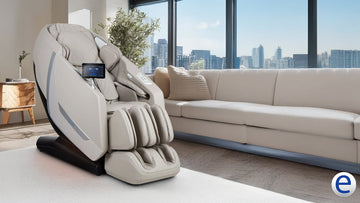How it Deep Tissue Massage Relieves Pain and Tension
Deep tissue massage isn't just about relaxation; it's a scientifically-supported therapeutic technique known for its ability to alleviate pain and tension. With recent advancements in massage chair technology, experiencing the benefits of deep tissue massage has become more accessible than ever. In this article, we'll explore the science behind deep tissue massage, uncovering its mechanisms and diverse applications in promoting health and wellness.
What is Deep Tissue Massage?
Deep tissue massage comprises a range of therapeutic methods aimed at accessing and manipulating the deeper layers of soft tissue beneath the skin's surface. This form of massage therapy aims to relax and elongate these tissues, fostering injury recovery, pain alleviation, and the restoration of proper posture and body mechanics.
Muscle imbalances can arise from various factors, including injury, repetitive movements, prolonged desk sitting, poor posture, or sports activities that unevenly engage specific body parts. Deep tissue massage specifically targets these deeper muscle layers and connective tissues.
The primary objective of deep tissue massage is to alleviate chronic muscle tension, diminish pain, and enhance mobility. It can be particularly advantageous for individuals experiencing conditions such as chronic back pain, stiffness in the neck and shoulders, sports-related injuries, and postural irregularities.
What is the difference between Deep Tissue Massage and other massage Techniques?
- Shiatsu Massage: Deep Tissue Massage targets deep muscle tissue to alleviate tension and pain, while Shiatsu focuses on applying pressure to specific points to balance the body's energy flow and promote relaxation.
- Swedish Massage: Deep Tissue Massage is more focused on targeting deep-seated tension and addressing specific musculoskeletal issues, whereas Swedish Massage is typically chosen for its soothing and general relaxation effects.
- Thai Massage: Thai Massage offer therapeutic benefits, they differ in their techniques, cultural origins, and intended outcomes. Deep Tissue Massage focuses on deep muscle manipulation to relieve tension and pain, while Thai Massage incorporates stretching and yoga-like movements to promote flexibility and balance energy flow.
Benefits of Deep Tissue Massage
Deep Tissue Massage offers a myriad of benefits beyond mere relaxation. From alleviating anxiety and depression to enhancing range of motion and relieving pain, its therapeutic effects extend to various aspects of physical and mental well-being. Deep Tissue Massage can positively impact areas such as lung function, headaches, and specific pain conditions, offering a holistic approach to health and vitality.
Pain Relief
Deep Tissue Massage has shown promising results in alleviating chronic low back pain. Studies indicate that it effectively reduces pain in patients with this condition. Additionally, the combined use with NSAIDs has been found to contribute to significant reductions in low back pain, comparable to the effects of Deep Tissue Massage alone. [1]
Deep Tissue Massage has demonstrated benefits for women recovering from cesarean sections. It has been associated with decreased pain levels and increased comfort among women undergoing this procedure. [2]
Massage therapy, including Deep Tissue Massage, has shown effectiveness in reducing postoperative pain, providing relief in both short-term and long-term recovery periods. [3]
Studies have demonstrated that Deep Tissue Massage (DTM) effectively reduces neck pain. When integrated into conventional rehabilitation programs, DTM has been associated with favorable outcomes in alleviating neck pain disability and enhancing overall quality of life. [4]
Improved Range of Motion
Deep Tissue Massage has proven effective in enhancing neck range of motion and reducing pain. Targeting specific neck muscles during a single massage session can bring significant relief and improved mobility, with benefits lasting up to two weeks afterward. Moreover, when combined with traditional rehabilitation programs, Deep Tissue Massage has shown positive outcomes in addressing neck pain, disability, and overall quality of life. This underscores its safety, affordability, and potential as a valuable treatment option for patients seeking relief from neck-related issues. [5]
Lung Function
In a study investigating Deep Tissue Massage and lung function, researchers discovered that participants who received the massage experienced improved chest expansion. Additionally, the group that received Deep Tissue Massage showed enhancements in breathing capacity and oxygen levels, whereas the control group didn't show significant changes.{6] Another study suggests that manual therapy, such as Deep Tissue Massage, might have positive effects on breathing, particularly when paired with light exercise beforehand.[[7]
Headaches
While further research with a larger group is needed to fully understand the effects of massage therapy on headaches, current data suggests its potential benefits. In a recent study focusing on individuals experiencing frequent headaches, each participant received two 30-minute massages weekly for four weeks. The results showed a significant reduction in the average number of headaches per week, decreasing from 6.8 to 2.0. Additionally, the duration of headaches decreased, with most lasting between 2.3 and 4.3 hours compared to the initial duration of 4.3 to 8 hours. Moreover, 75% of participants reported a decrease in headache intensity. [8]
Anxiety and Depression
Scientific research has demonstrated that massage therapy can effectively alleviate symptoms of anxiety and depression. Studies have indicated that massage therapy sessions lasting five weeks or longer resulted in significant improvements in pain, anxiety, and depression among patients. [9]
Who shouldn’t get a Deep Tissue Massage?
Deep tissue massage isn't suitable for everyone, particularly those:
- Taking blood-thinning medications, as deep pressure could cause bruising or other complications.
- At risk for blood clots, as deep tissue massage could potentially dislodge a clot.
- Who have recently experienced trauma to the body, such as surgery or an accident, as deep pressure may exacerbate the injury.
- Undergoing radiation or chemotherapy, as their bodies may be too sensitive for deep pressure.
- Diagnosed with lymphedema, as deep tissue massage could worsen swelling and discomfort.
Technology in Massage Chairs for Deep Tissue Massage
Modern massage chairs are equipped with advanced technology that replicates the techniques used in professional massage therapy. Key features found in massage chairs for deep tissue massage include:
- 3D/4D Massage Rollers: These rollers mimic the hands-on techniques of a skilled massage therapist by adjusting the depth and intensity of the massage strokes. This feature allows for a more customized and effective massage experience.
- Air Compression Massage: In addition to rollers, many massage chairs incorporate airbags that provide compression massage to target specific muscle groups. This helps improve circulation, reduce swelling, and enhance overall relaxation.
- Heat Therapy: Some massage chairs offer heat therapy functions that apply gentle warmth to the muscles. Heat helps to increase blood flow, relax tight muscles, and alleviate pain, making it an excellent complement to deep tissue massage techniques.
- Zero Gravity Recline: The zero gravity position, inspired by NASA technology, reclines the body into a neutral posture where the legs are elevated above the heart. This position reduces spinal pressure, promotes spinal alignment, and enhances the effectiveness of deep tissue massage.
- Convenience: One of the significant advantages of massage chairs is their convenience. Users can enjoy a deep tissue massage in the comfort of their own home, without the need to schedule appointments or travel to a massage therapist. This accessibility allows for more frequent sessions, which can contribute to better overall relaxation and pain relief.
Conclusion
In conclusion, deep tissue massage stands as a scientifically-backed therapeutic technique offering profound relief from pain and tension. With advancements in massage chair technology, these benefits are now accessible within the comfort of one's home. From targeting muscle imbalances to enhancing lung function and relieving headaches, deep tissue massage exhibits a comprehensive array of benefits that extend beyond mere relaxation. Its efficacy in addressing chronic pain conditions, improving range of motion, and even alleviating symptoms of anxiety and depression underscores its significance in holistic well-being.
Modern massage chairs equipped with advanced technology have revolutionized the accessibility of deep tissue massage. Features such as 3D/4D massage rollers, air compression massage, heat therapy, and zero gravity recline offer a customizable and convenient massage experience, contributing to improved relaxation and pain relief from the comfort of home.
Additional Links
References
[1] Majchrzycki M, Kocur P, Kotwicki T. Deep tissue massage and nonsteroidal anti-inflammatory drugs for low back pain: a prospective randomized trial. ScientificWorldJournal. 2014 Feb 23;2014:287597. doi: 10.1155/2014/287597. PMID: 24707200; PMCID: PMC3953439. Link
[2] Güney E, Uçar T. Effects of deep tissue massage on pain and comfort after cesarean: A randomized controlled trial. Complement Ther Clin Pract. 2021 May;43:101320. doi: 10.1016/j.ctcp.2021.101320. Epub 2021 Jan 28. PMID: 33548749. Link
[3] Liu C, Chen X, Wu S. The effect of massage therapy on pain after surgery: A comprehensive meta-analysis. Complement Ther Med. 2022 Dec;71:102892. doi: 10.1016/j.ctim.2022.102892. Epub 2022 Oct 26. PMID: 36309174. Link
[4] Bingölbali Ö, Taşkaya C, Alkan H, Altındağ Ö. The effectiveness of deep tissue massage on pain, trigger point, disability, range of motion and quality of life in individuals with myofascial pain syndrome. Somatosens Mot Res. 2024 Mar;41(1):11-17. doi: 10.1080/08990220.2023.2165054. Epub 2023 Jan 16. PMID: 36645811. Link
[5] Kaczmarek T, Truszczyńska-Baszak A. The Impact of Suboccipital Muscle Release on Pain and Range of Motion in the Cervical Spine of Young Adults. Medical Rehabilitation. (2023);27(1):11-19. Link
[6] Trybulec B, Macul B, Kościńska K, Nawrot-Porąbka K, Barłowska M, Jagielski P. The effect of deep tissue massage on respiratory parameters in healthy subjects-A non-randomised pilot study. Heliyon. 2023 Apr 5;9(4):e15242. doi: 10.1016/j.heliyon.2023.e15242. PMID: 37151693; PMCID: PMC10161605. Link
[7] Roger M. Engel, Subramanyam Vemulpad, The Effect of Combining Manual Therapy with Exercise on the Respiratory Function of Normal Individuals: A Randomized Control Trial, Journal of Manipulative and Physiological Therapeutics, Volume 30, Issue 7, 2007, Pages 509-513, ISSN 0161-4754. Link
[8] Quinn C, Chandler C, Moraska A. Massage therapy and frequency of chronic tension headaches. Am J Public Health. 2002 Oct;92(10):1657-61. doi: 10.2105/ajph.92.10.1657. PMID: 12356617; PMCID: PMC1447303. Link
[9] Li YH, Wang FY, Feng CQ, Yang XF, Sun YH. Massage therapy for fibromyalgia: a systematic review and meta-analysis of randomized controlled trials. PLoS One. 2014 Feb 20;9(2):e89304. doi: 10.1371/journal.pone.0089304. PMID: 24586677; PMCID: PMC3930706. Link





